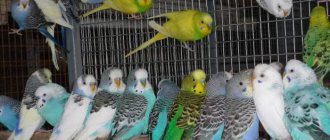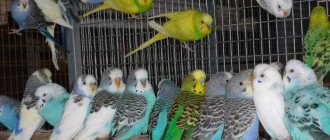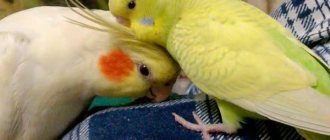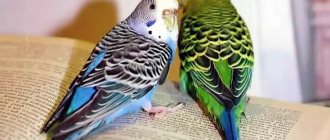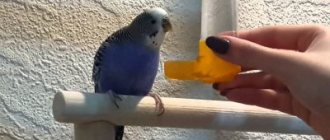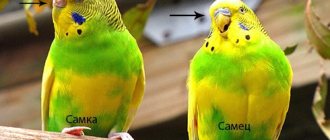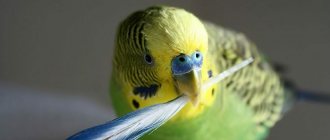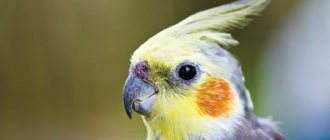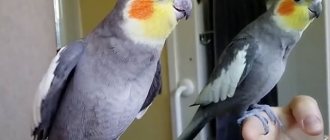The question of how to determine the sex of a budgerigar faces home breeders of these birds in many situations. For example, when buying a pet at the market, when the buyer is not confident in the honesty or competence of the seller. This question is very important for the following reasons:
- In order to choose the right name for a parrot, you need to know for sure whether it is a boy or a girl.
- When placing birds together in a cage, you need to know their gender. Representatives of the stronger sex usually get along quite calmly with each other. But females in many cases begin to conflict. The matter may even end in the death of one of the birds.
- It is extremely important to distinguish the sex of a budgerigar before taming and training it. Males are tamed faster and learn to talk faster, since their speech abilities are more developed. Females are much more difficult to train and the owner will have to show maximum patience during this process. But even from a trained girl it is difficult to expect the same inclination to communicate with the owner as from a boy.
How can you tell if a parrot is a boy or a girl? Biological science and many years of practical experience of many generations of poultry keepers have provided several methods at the disposal of modern bird lovers. A few words must be said about each of them.
What is the difference between a female and a male and why is it important?
The female parrot differs from the male in a number of significant characteristics. When getting a parrot, you need to decide on its habitat and come up with a name for your pet. Some owners want their pet to learn to talk, while others don't need this. Factors depending on the sex of the bird:
- Name. Knowing the gender of your feathered pet, it is much easier to come up with an original name for it. Having named the boy's parrot Gosha, it will be strange to find a nest with eggs in his cage. All that remains is to choose a neutral nickname, without taking into account the individual characteristics of the bird.
- Breeding chicks. In order to start a family of budgies, you need to place a couple of birds of different sexes in a cage. If the breeder does not know how to distinguish between a boy and a girl parrot, it will be extremely difficult to obtain a brood.
- The life of two birds in one cage. While males get along well together, females often do not get along with each other. The birds will often clash, which can lead to the death of one of the females.
- The ability to reproduce sounds. Almost all budgies can learn to speak. The question is how long will it take. The difference between a male and a female in terms of speech is that boys are easier to train. Girls require more patience and time, but speak more clearly than males.
- Features of behavior. Male budgies are friendlier than restless females. They react positively to human hands, and if they bite, it is only to express displeasure. Females most often do not like to communicate closely with the owner. This manifests itself especially strongly during a surge of hormones, when even a calm girl behaves aggressively.
When choosing a budgie, a person knows in advance what kind of bird he would like to purchase. If you dream of a noisy bird, you should choose a female. Males behave calmly and learn to speak faster.
Who is better to choose: male or female
Females and males have their own advantages and characteristics. First you need to decide for what purposes a pet is needed in the house, and in what conditions its life will be spent. When the task is clear, the choice is easy to make.
In what cases is it better to purchase a male:
- when the owners are often at home, rarely go on business trips and are ready to devote a lot of time to communicating with the pet;
- if you want a talkative friend to appear in the family;
- so that there is more than one parrot, but at the same time eliminate the risk of offspring;
- if there are small children in the house who are ready to communicate with a feathered pet (the female can bite painfully).
The female must be selected under the following circumstances:
- when there is already a male who needs a girlfriend, and the household members are ready for the fact that chicks may appear;
- if the owners do not like a lot of noise and are rarely at home (females tolerate loneliness more calmly);
- in cases where the owners do not care whether the parrot will talk or not (females are not as sociable and talkative as males).
When the task is to purposefully breed parrots, then you need to choose birds of any sex from different breeders. Because in one place a male and a female may end up from the same parents, and they will not be able to produce healthy offspring.
How to determine the sex of a budgerigar by its cere
You can tell a boy's budgie from a girl's by looking at its wax. The cere is a supra-beak formation in which the nostrils are located. Determining the sex of a parrot is carried out by studying the wax itself, or rather its color. However, there is an important nuance: with age, the shade of the beak formation changes, so sex determination in chicks and adults is different.
Chicks
In order to accurately determine the sex of a budgerigar, you need to have an idea of the differences in the color scheme of the cere in males and females. The sex of the bird is determined starting at four weeks of age. If the budgerigar in front of you is a male, the chick’s beak formation may have the following features:
- The predominant color is pink, as well as shades of violet and lilac;
- The cere has a uniform color;
- Sometimes you can see bluish circles around the nostrils.
The cere of a female budgerigar has the following differences:
- The formation is blue or has a light shade of pink and purple;
- The color is uneven, turning into white circles around the bird’s nostrils;
- Parrots of any gender have a purple beak. Note the blue color of the wax, characteristic of the female.
- The pink cere is not a distinctive feature of the bird. In this case, you need to look at the circles around the nostrils.
It is difficult to remember color combinations right away. When going to the pet store, take with you a printout of the characteristic sexual characteristics of budgerigars.
It is not always possible to immediately distinguish boy parrots from girls. During the day, the color of the wax may change. If the parrot is already in your arms, it is better to note the shade of the beak formation a couple of times. You can take several photos to clearly see the change in color of the wax.
Adults
While the cere of young parrots is constantly changing, the beak structure of an adult bird is fully formed. Thanks to this, it is easier to distinguish the sex of budgerigars at the age of 3-4 months than in the early stages.
In order to find out the gender of your pet, it is enough to know two characteristic colors.
Throughout her life, the girl's budgerigar's cere retains clear white perinorecal circles. The rest of the cere tends to beige shades with age, often turning brown. If you notice a brown beak formation on a bird, you can be sure that this is a female. The color of the beak may change depending on the hormonal background. Females are also characterized by an uneven, rough surface of the wax. During nesting, a small growth may appear on it, which subsequently disappears. Albinos, lutinos and other mutated species are identified by the same characteristics.
The male budgerigar has a bright blue cere, and the color of its beak can also change throughout its life. The beak of albinos and lutinos does not change color, remaining pink. Sometimes blue spots on the beak can be seen in male budgies susceptible to the mutation.
Recommendations
To eliminate errors, the sex of the parrot must be determined by several indicators, proceeding in the following order:
- Examine the wax on a young or adult bird.
- Take a series of photos if the parrot is young, and examine the shades of the beak and the circles around the nostrils.
- Observe the behavior of the bird alone and in communication with other parrots (if he is not alone in the cage).
- Listen to the sounds it makes - males make more noise and sing louder.
An important point is not to make hasty conclusions based on one indicator. There are many varieties of birds, and each bird, in addition to its physiological characteristics, also has its own character.
Budgerigars can live at home for 12-15 years. Therefore, it is important to immediately correctly determine the gender of a future family friend. To do this, you need to study its external features and behavioral characteristics in order to provide it with a decent life in the future and enjoy communicating with your pet.
Genetic method
Determining the sex of a budgerigar using the genetic method is used only if the breeder finds out the sex of the chick from the parents known to him. At birth, a parrot has a phenotype that is made up of the characteristics of its father and mother. This method is used for mutations linked to the sex of the bird. These include ino, slate, cinnamon, opaline, etc. parrots. It is on the basis of the mutation that the sex of the chicks is determined using the genetic method.
For example, if normal parents give birth to an opaline-colored chick, this is a female, and a cinnamon-colored boy will give birth to females of the same color. The genetic method is quite difficult, but it will help to accurately determine the sex of a budgerigar.
Exceptions to the rules
In all the variety of budgerigar breeds, there are mutation breeds, the so-called “inos” (including lutino, albino), and also recessive variegated and pure parrots, the methods described here are not suitable for determining the age of which.
Lutino and albino
- Mutation breeds always have black eyes, the irises never stand out.
- Lutino and albinos have red eyes.
- Representatives of these breeds very rarely have a black beak, even when very young. Except that in birds with light plumage up to 25 days of life, you can notice a blackish spot on the beak.
- It is impossible to determine age by the “waves” on the heads of parrots, since these breeds do not have such waves, they are all smoothly colored.
- The light pink or bluish cere of males remains unchanged throughout their lives. In females of these breeds it changes at the same time as in ordinary breeds of budgerigars.
Exceptions to the rules occur not only in mutations , but also in standard budgies. Here is a photo of a young, 2-3 month old boy who does not yet know what molting is, but already has a blue cere and a white iris - signs of adult males:
Alternative Methods
Sometimes the sex of a bird is determined by observing sexual intercourse or its imitation. The female budgerigar is on the bottom. The male has a tendency to place his foot on his partner or any suitable object.
How to distinguish a female and a male budgerigar by behavior? If the bird is curious, observant and likes to clean up its cage, it is definitely a female. Girls often bite, and noticeably. The peak of their aggressiveness occurs during the period of hormonal surge. Males are calmer in this regard; their bites are more indicative. Girls take a long time to learn to speak simple words, and boys sing complex songs.
To determine the sex of a budgerigar, you should look at the shade of the pet's wax. Expensive methods, such as DNA analysis, are used to study the bird's characteristics in detail. Knowing the characteristics of the behavior and appearance of parrots of different sexes, gender is determined independently with maximum accuracy.
If you liked the article or have something to add, then leave your comments and also join our VKontakte group.
Definition in some species
Lovebirds
This species of birds is characterized by weak sexual dimorphism: it is almost impossible for a non-specialist to distinguish a girl from a boy. Males are very similar to females, and vice versa.
There are just a few subtle differences:
- Head shape. The male has an elongated head, but the forehead line is low. Females have a more rounded head shape.
- The position of the paws while sitting on the perch (the method is applicable only for mature birds). Males keep their paws close to each other, while females have their paws wide apart.
- The previous sign is related to the width of the pelvic bone. You need to carefully feel the rounded parts of the pelvic bones on the bird’s belly. They feel like match heads to the touch. The size of the bones themselves is larger in females - about 1 millimeter, in males - no more than 0.5 millimeters.
Most often, the sex of lovebirds can be determined by sexual behavior: males court the female for a long time.
Corella
Determining the sex of a cockatiel is also very difficult, but it is possible after a little practice.
Characteristic differences:
- Males have a longer and brighter crest on their heads, with a pair of green feathers. In females it is shorter, wider and duller.
- After molting, the feathers of males acquire a yellow tint, while females remain gray. During the mating season, males become much brighter.
- Females have a hump on their back, while males have a straight back.
- Females are plumper and rounder, their partners are fit and slender.
- Girls have a vertical parting of feathers on their tummy; boys do not.
- Males have a sharp, long and neat tail. In females it is wider.
Please note that it is reliably possible to distinguish a boy from a girl cockatiel only after the birds reach the age of 3.5-4 months.
Wavy
All the features of determining the sex of “volnushki” were described in detail above. If you are in a pet store and want to immediately find out the gender of the bird you like, listen to the inhabitants of the cage. Girls will be silent, and boys will sing or cheerfully tweet.
It is a mistaken belief that female budgies cannot speak. This is wrong. Females take longer to learn to speak, but pronounce words more clearly than males.
Jaco, rosella
For these two species, only a genetic test will help to make a complete determination - individuals of different sexes are so similar to each other. There are a number of almost imperceptible differences. Let's take a closer look at them.
Jaco:
- Males have a flatter head and a shorter neck. Females are distinguished by a round head and a long neck.
- Males are thick and round, females are slightly slimmer.
- The scarlet tail feathers of males are slightly darker.
- Grays have thin stripes on the inside of their wings. Their color is different: females have gray and whitish stripes, males have gray and dark gray stripes.
These large birds mature fully only by 1.5 years; it makes no sense to determine sex earlier.
Rosella:
- In females, the head is rounded and smaller; in males, the back of the head is slightly sloping.
- The base of the male's beak is wider and more massive.
- Females have a thin white stripe on the inside of the wing.
It makes sense to find out the gender of a Rosella pet only after six months of age.
Ozherelovye
Finding out the sex of necklaces before puberty is very difficult - a DNA test will be required. As the bird grows older, the determination becomes easier.
Main features:
- Males have brighter plumage with a pronounced black and pink necklace.
- Males have a squarer head than females.
- Girls have a shorter and wider tail.
These signs are finally formed only upon reaching the age of three.
Advantages of buying from a breeder
Professional parrot breeders sell their pets ringed. The ring on their foot indicates the date of birth of the chick and the country or nursery where these birds are sold. Sometimes the number of the chick is also indicated. The ring is put on by a nine-day-old bird. This is a kind of parrot passport that dispels doubts about its age.
But even here you can be deceived! Make sure that the ring is solid and non-removable. And it didn’t look as if it had been pinched yesterday on the leg of an adult bird with forceps, and today it was being sold to you as a young bird.
Corella parrot: the difference between a boy and a girl
Many people keep at home tame talking parrots of the Corella genus, which have a short beak, a long pointed tail and a funny crest. Unlike other species of parrots, they have duller plumage. The most common shades are white, yellow and gray. The gender of Corella parrots is easily determined by their characteristic features.
How to distinguish a female from a male:
- In females, the color of the plumage is darker below, light yellowish in the head area. The feathers are gray, with brownish spots on the cheeks. The character is calm.
- Males have brighter plumage color. The head and crest are a rich yellow hue. There are orange spots on the cheeks. The color of the feathers on the wings and tail is bluish-black.
How to distinguish lovebirds
The most faithful domestic birds are lovebirds. They have an agile and active nature, often display curiosity and are good at imitating human speech.
How to determine the sex of a lovebird:
- Males have a more expressive plumage color.
- Males have an angular nape, while females have a rounded shape.
- The beak of boy parrots is large and wide at the base. There may be a small groove in the middle.
- Girls have a pale, rounded beak.
- Sex can be determined by the pelvic bones. In females they are wider and reach approximately 1 cm; in males they often do not exceed 0.5 cm.
- Boy parrots have a calmer character. They do not lose their composure when listening to the “swearing” of an often dissatisfied companion. They can take care of their spouse by feeding her grains from their beak and combing out her feathers. Females are grumpy and economical, often hiding food for storage.
A test can be performed to determine gender. Place pieces of paper in the cage. The female will tear pieces to form a nest, which is characterized by caring for the offspring. Males do not show interest in paper.

